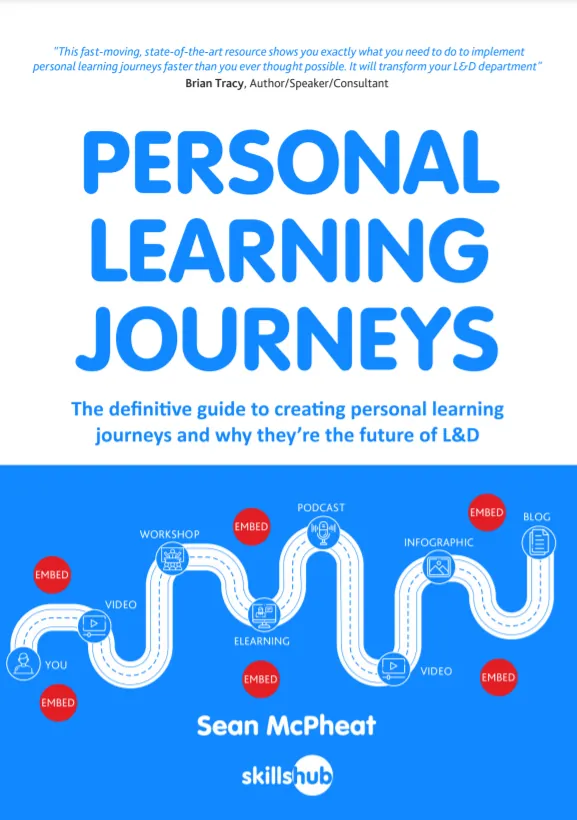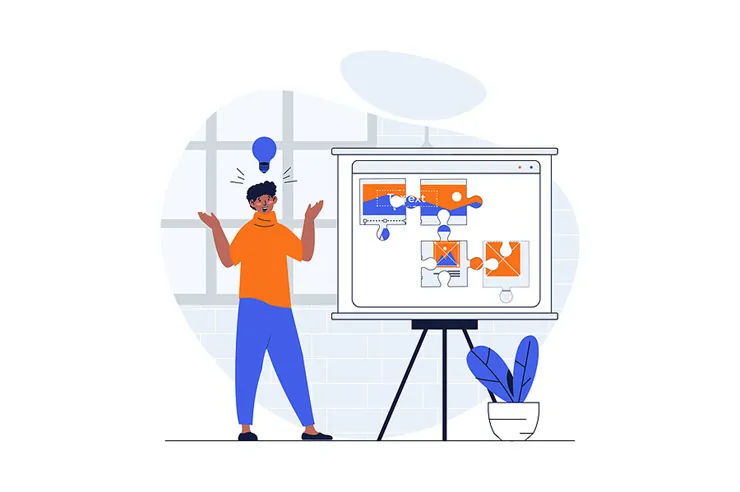
Training & Development is vital for nurturing a skilled workforce capable of driving organisational growth.
As an eLearning company, we recognise the importance of creating continuous learning and improvement within your organisation.
In this guide, we’ll delve into 13 effective strategies to bolster training and development initiatives in your organisation. From crafting bespoke eLearning training programs to harnessing technology and creating a culture of learning, we’re here to assist you in unlocking the full potential of your workforce and securing sustainable success.

What is Training & Development?
Before we dive into the strategies, let’s establish a foundation by understanding what training and development actually entails and why it’s critical for your organisation’s success.
As its name suggests, training and development has two components:
- Training, being the act of teaching regular processes and procedures vital to the successful fulfilment of a role.
- Development, the process of improving or expanding an existing employee’s skillset, allowing them to take on new roles or responsibilities.
Training is required for all employees.
And development, although not strictly essential, is necessary if you want to retain and upskill the best employees to build a talented workforce.

Learn How To Create Personal Learning Journeys For FREE!
The Importance of Training & Development
Training and development go beyond merely imparting knowledge. They are about equipping your team with the skills and insights needed to excel in their roles and adapt to the evolving demands of the market.
As Katherine Haan wrote in a recent article in Forbes, “while training focuses on job-specific skills, development is about long-term growth and behavioural change, and both are important.”
We are living in a time of rapid change. Automation, AI, and machine learning are revolutionising a host of industries and the roles that are vital to those sectors.
Entirely new jobs in data validation and LLM training, for instance, have sprung into being in recent years, requiring brand new skill sets.
If you don’t invest in the training programs you need to take advantage of technological change, you may be left behind by your competitors.
Training and development are vital for staff retention too.
A 2019 LinkedIn report revealed that a staggering 94% of employees would likely remain with an employer who invests in their personal development.
The Role of Training & Development in Organisational Success
Training and development play a pivotal role in the success of any organisation. They are the engines that power innovation, efficiency, and competitiveness.
By investing in these areas, you’re not just improving individual performance but are also enhancing your team’s collective capacity to drive forward. If you want to remain at the forefront of innovation, it pays to invest in upskilling the areas where your industry is changing most quickly.
With a well-trained and innovative pool of talent, you’re in a better position to spot new opportunities and move quickly to seize blue ocean markets.
Lastly, when your staff are professionally trained, your business will operate at greater efficiency with less waste and attrition. By investing in ongoing in-house learning and development programs, you don’t have to kickstart new programs whenever changes in your sector require urgent upskilling.
Entrepreneurs’ Opinions on Training and Development
How do successful companies feel about their training and development programs?
Here are just three quotes from business pioneers over the last 100 years:
“Anyone who stops learning is old, whether at twenty or eighty. Anyone who keeps learning stays young.”
Henry Ford, Automotive Pioneer
“We now accept the fact that learning is a lifelong process of keeping abreast of change. And the most pressing task is to teach people how to learn.”
Peter Drucker, Management Guru
“The upside of painful knowledge is so much greater than the downside of blissful ignorance.”
Sheryl Sandberg, Facebook CEO
Looking for even more inspiration? Check out these 25 Learning and Development Quotes to Inspire You
Benefits of Investing in Training & Development Programs
Investing in such programs yields substantial returns. Let’s summarise the benefits of training and development and prioritising programs:
- Improved employee performance, with efficiency gains.
- Higher job satisfaction levels, and employee retention.
- Greater innovation, and improved competitiveness.
- Cost savings through ease of implementation of in-house L&D.
These are the four main reasons to focus on this aspect of human resource development, and they are substantial ones.
Inculcate a culture of continuous development, and your business will be optimised to remain agile, innovative, and fit for the rapidly evolving twenty-first century.

Importance of Effective Training & Development Strategies
To reap these rewards, however, it’s crucial to employ effective training and development strategies that resonate with your workforce and align with your organisational goals.
Common errors to avoid when shaping your learning and development strategy:
- Training and development instituted without sufficient canvassing of employee skill wants, needs, and deficits.
- Excessive reliance on external consultancies without shaping an in-house culture of learning and development.
- Training and development not aligned with overall corporate strategy.
- Training materials are poorly tailored to the specific needs of employees, and instead feel arbitrary and irrelevant.
- Training does not suit new corporate skill sets and priorities and is insufficiently future-focused.
All the above considerations are important when designing or selecting a training and development strategy. After all, it can be an expensive and long-term investment, so it pays to put as much thought into the selection process as possible.
13 Strategies for Enhancing Training & Development
Given the complexity of the task of choosing the right L&D program, let’s explore thirteen strategies that can revolutionise your training and development efforts.
Strategy 1: Implementing Tailored Training Programs
Develop training programs designed to meet the unique needs and learning styles of your employees. Customisation ensures relevance and employee engagement.
Personalisation is especially possible in online training, where a modular approach can be adopted. Rather than running one-size-fits-all classes, employees can choose from a menu of options, to ensure they have access to valuable and important courses.
Ideally, each employee will have a personal development plan which may also include tailored incentives for course completion.
Strategy 2: Encouraging Continuous Learning Opportunities
Create an environment where learning is continuous and supported by various resources, including online courses, workshops, and seminars.
Courses should combine subject matter, content, or guest speakers to inspire your employees, so that continuously upskilling feels rewarding rather than onerous.
Consider hosting industry seminars, events, and learning & development conferences where attendees can encourage one another to develop their knowledge and interests. This can help position your business at the forefront of thought leadership in your sector.

Strategy 3: Leveraging Technology for Learning Enhancement
Utilise the latest technological tools and platforms to make learning more accessible, engaging, and effective. From eLearning platforms to mobile learning apps, technology can significantly enhance the learning experience.
This permits employees to engage in learning experiences at a time and location that suits them. It also makes learning more fun by allowing course designers to incorporate quizzes and gamification to build engagement.
Additionally, using online platforms or apps for e-learning courses delivers a host of metrics that L&D professionals and managers can use to improve course content. These include time on task, quiz results, and voluntary feedback from participants.
Strategy 4: Establishing Mentorship and Coaching Programs
Pair employees with mentors or coaches who can provide them with guidance, support, and feedback to facilitate their professional growth. Such mentors can be sourced from within, or without, the organisation.
Another option is to offer short-term “shadowing” programs, where employees learn new skills by assisting a senior staff member from a different department or team.
Such programs help promote learning by leveraging the desire of mentees to please their mentors, and the pleasure of personal interaction, rather than individual lone study.
It’s important to make sure mentors and coaches can spare sufficient time to assist their mentees. Boundaries must be agreed upon to ensure that mentees don’t expect unreasonable access.
Strategy 5: Providing Feedback and Recognition
Regularly provide constructive feedback and recognise achievements to motivate employees and encourage their development. Don’t simply rely upon auto-generated certificates and praise. Make sure you actively and personally congratulate employees for upskilling or passing course exams.
You can offer recognition in the form of incentive programs, or team nights out once every member has completed a training program.
It’s important when offering constructive criticism to use a strategy such as the “sandwich” technique, where you begin by noting the student’s achievements, then offer criticism, and finish with a note of praise. This technique has been shown to be the most effective and least wounding.
Strategy 6: Offering Career Development Opportunities
Enable employees to advance their careers within the organisation by providing clear pathways and personal learning journeys for development.
As we saw, the potential for advancement is one of the primary motivators for new employees. It is also one of the best ways to retain in-house talent.
As well as on-the-job training for employees, consider allowing employees to “act up” into roles they would like to explore, where possible. This allows staff members to try out new roles, with supervision, without committing to a permanent change.
You can also invest in sending employees to external conferences and events where they can expand their horizons, learn new skills, and make valuable contacts, as well as acting as ambassadors for your business.

Strategy 7: Create a Culture of Collaboration and Knowledge Sharing
Encourage a collaborative environment where employees are motivated to share knowledge and learn from one another. You can use technological platforms like Slack or Discord to provide spaces for employees to share information and advice.
Build a set of resources, ideally using interactivity and audiovisual content, to allow employees to become self-sufficient when seeking the answer to their queries.
When working on innovative projects, try to create multidisciplinary teams from across the organisation—you never know where inspiration will come from.
Strategy 8: Promoting Work-Life Balance and Wellbeing Initiatives
Recognise the importance of work-life balance and wellbeing in employee performance and provide programs that support these aspects.
When planning your training and development program, it’s important not to neglect wellbeing. By educating employees how to take care of themselves, you build more energetic, happier, and more productive workers. You also reduce churn and improve overall staff morale.
You can even institute social programs and classes such as meditation, yoga, book clubs, or sports. This can help build team cohesion and make your workplace a more attractive proposition, particularly in this age of hybrid or remote working.
Strategy 9: Conducting Regular Training Needs Assessments
Regularly assess the training needs of your employees to ensure that your programs remain relevant and effective. Don’t assume that your training needs will remain constant, since they will naturally shift alongside:
- Changing demographics in your employee pool
- Different patterns of working (i.e., flexitime, hybrid, or remote workers)
- Technological or social changes within your sector.
- Changing roles and responsibilities of staff.
- Difference needs prompted by upscaling, mergers, or rebranding.
These are just five of the factors that might prompt a reassessment of your training and development needs. There are many more. Given how many parameters may change, it’s worth assessing your L&D program at regular intervals, as a matter of course.
Needs assessments can include focus groups, staff surveys, analytics, and audits of competitors’ training programs.
Strategy 10: Investing in Leadership Development Programs
Develop the next generation of leaders within your organisation by investing in programs that hone leadership skills. There are a host of external providers, including Skillshub, offering leadership training, which can be tailored to the specific needs of your brand, business, and sector.
Soft skills are big now. These are transferable intuitive skills that focus on empathy, communication, motivation, and management. Such skills are relational, and therefore well suited to leadership training.
Leadership programs can be held in-house or can be undertaken off-site to focus attention. They should incorporate opportunities to work in teams, so that interpersonal skills can be demonstrated.
Such programs are a good way to trial promising employees and find out how well-suited they may be to leadership roles, as well as whether they are likely to enjoy such positions.

Strategy 11: Emphasising Diversity and Inclusion in Training
Ensure that your training programs are inclusive and cater to the diverse needs of your workforce. Try to avoid making assumptions about what “every employee” will want or appreciate.
Traditionally under-represented groups may feel less confident about offering challenging opinions or may feel that courses designed for “the majority” do not take account of factors that disproportionately disadvantage their members.
Again, there are specialist providers you can bring in to ensure you design your training with diverse workforces in mind. There are numerous online DEI resources and books you can draw upon too.
Equality and Diversity UK, for instance, provides a range of low-cost resources for employers to access when considering DEI principles in workplace training.
Strategy 12: Encouraging Peer-to-Peer Learning
Facilitate opportunities for employees to learn from their peers, creating a culture of mutual growth and support. For instance, if you invest in a new tech platform or tool, it can be helpful to train a few “champions” among your employees and then have those individuals share their knowledge with their teams.
This approach builds team cohesion and promotes a culture of cooperation and information sharing. You can use tools and platforms such as Notion, Asana, or Trello which encourage collaborative working and knowledge sharing.
You can also schedule regular presentations where teams explain their contribution to the organisation. In larger companies this can be an important way to ensure that no team or department is neglected, and everyone knows what everyone else is doing to further corporate strategies.
Strategy 13: Monitoring and Evaluating Training Effectiveness
Regularly monitor and evaluate the effectiveness of your training programs to identify areas for improvement and ensure they deliver the desired outcomes.
You can use a combination of means to achieve this, including:
- Automated participation and scoring metrics.
- Focus groups on training and skills gaps.
- Anonymised feedback forms (paper or online).
- External observers during training events.
These and other methods of evaluation ensure that your training programs are up to date and deliver the results you want. You’ll need to refresh your training and development offering at regular intervals, to make sure you’re getting value for money, and providing what your ambitious employees want and need.
Final Thoughts
Enhancing your organisation’s training and development efforts requires a comprehensive approach that incorporates a variety of strategies.
By implementing tailored training programs, leveraging technology, and creating a culture of continuous learning and collaboration, you’ll boost your team’s skills and productivity.
Explore Skillshub eLearning content and discover how our eLearning platform can streamline your training processes. We provide both in-house and online training solutions.
For a more immersive learning experience, consider our Virtual Training solutions. These tools will empower employees with the knowledge and skills needed for success in today’s fast-paced world.
Join us in reshaping the future of training and development and take the first step towards unlocking your team’s full potential.













